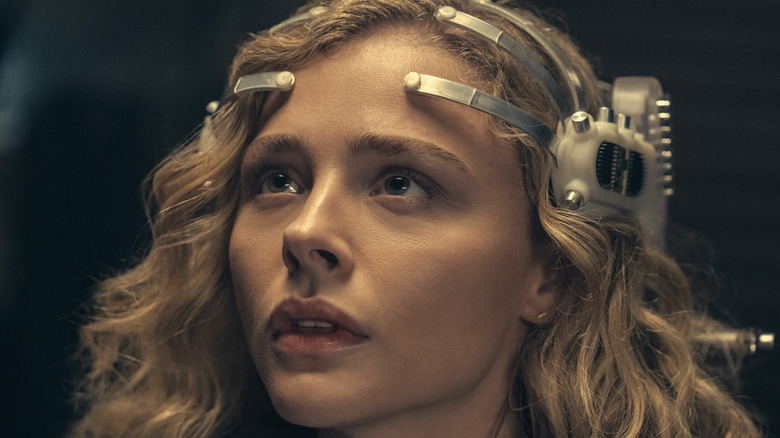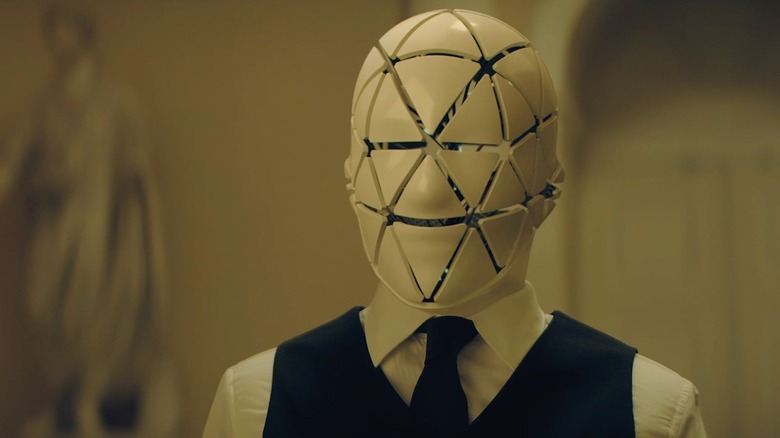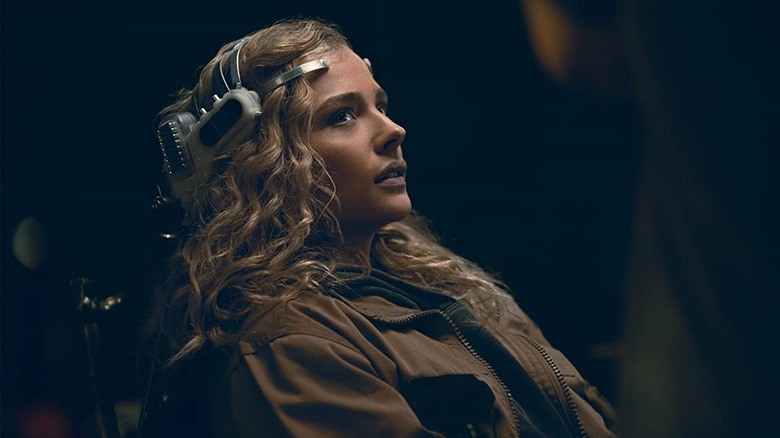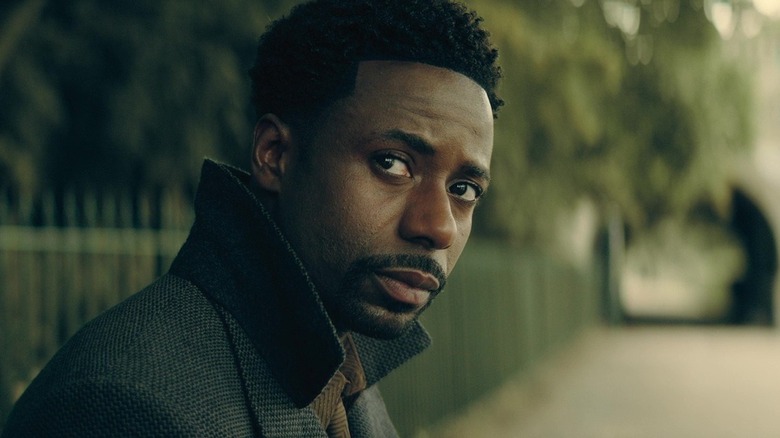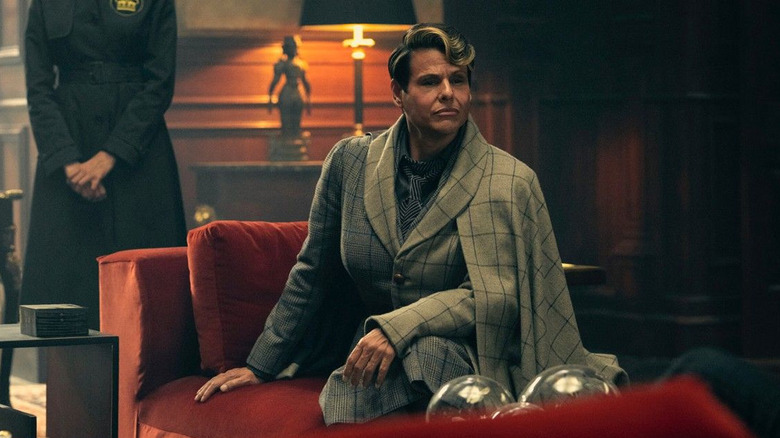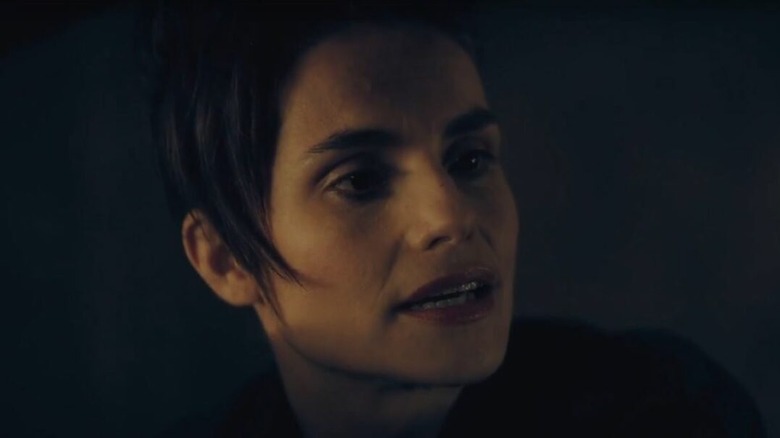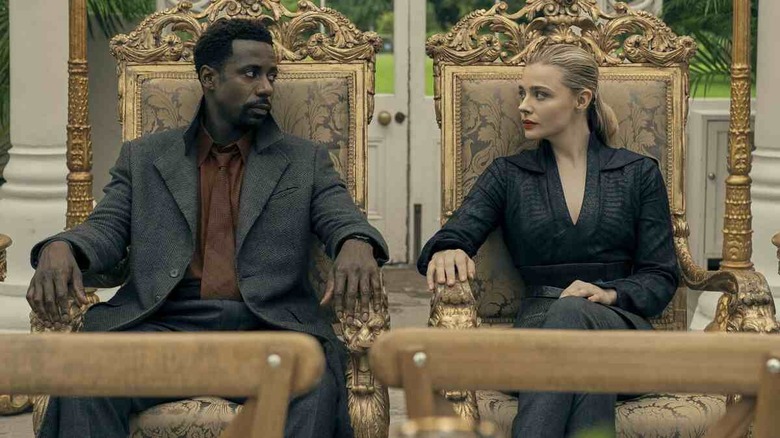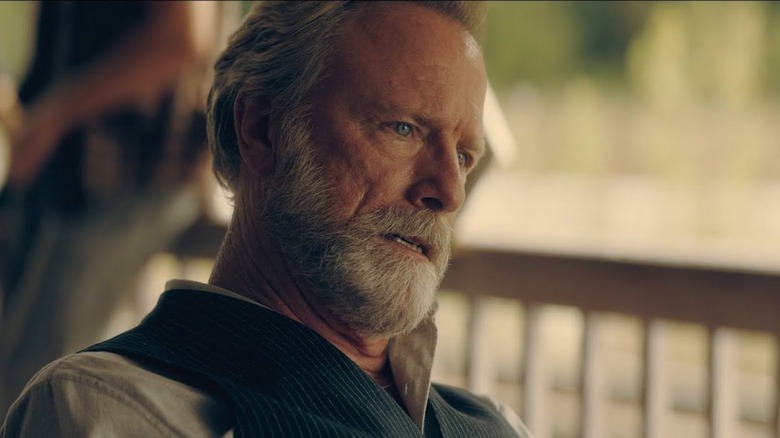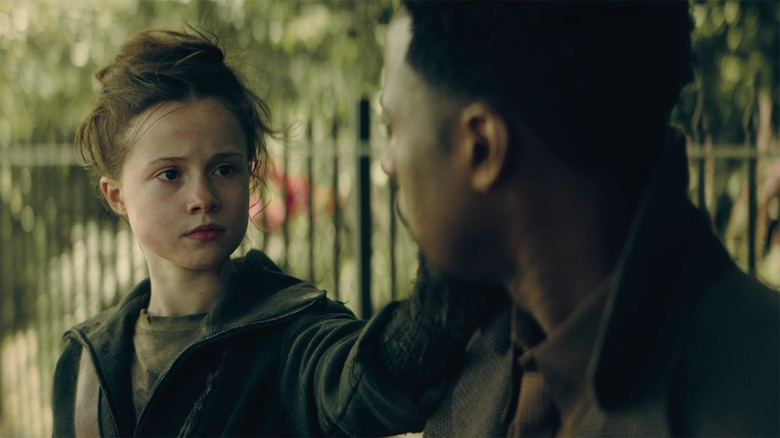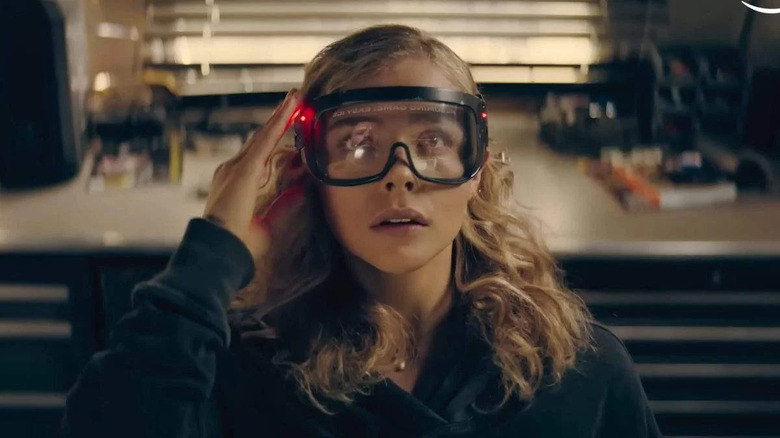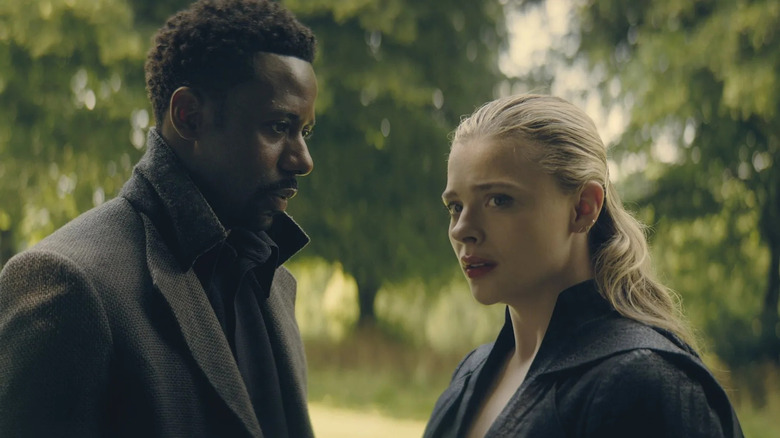The Biggest Differences Between The Peripheral Series And The Book
William Gibson is the mastermind behind dozens of sci-fi stories, some of which have been adapted into movies that aged poorly (we're looking at you, "Johnny Mnemonic.")
Back in 2014, Gibson published a sci-fi novel like no other: "The Peripheral." This thriller tells the story of two futures linked by a shared past and a mysterious data transfer technology. Flynne Fisher lives in a near future with plenty of domestic political conflict and some high-tech VR rigs. Ninety years ahead of Flynne exists a world wracked by a series of apocalyptic events known as the Jackpot. Some of the people in 2099 have the ability to open windows into an alternate past called "stubs"; when they do, the everyday lives of people like Flynne get upended.
"The Peripheral" is just the beginning of an exciting series of book-to-TV adaptations on Amazon Prime. The show takes the book's core concept and gives it a shiny new layer of chrome with a faster pace and more action than Gibson's comparatively contemplative writing, but the stories share common DNA. Gibson commented on Twitter that the show should be viewed as a "stub" of the book he wrote nearly a decade ago.
The differences between Gibson's novel and Amazon's show help illuminate the strengths and weaknesses of both versions of the story. If you've found yourself ensnared by Flynne's journeys to the future, you'll want to know where the show closes off certain avenues from its source material and where it opens up, literally, worlds of new possibilities.
The tech
There are many sci-fi concepts that "The Peripheral" needs to introduce to viewers before it can get its plot off the ground. The story takes place in two different futures, and each comes with its own set of technologies that are more advanced than our own. The barrage of new terms and tech can be enough to confuse even seasoned sci-fi veterans, but compared to the book, the show is incredibly easy to follow.
William Gibson doesn't do much hand-holding in his novel "The Peripheral." The book is told from the third-person point of view, but it's also very much coming from the perspective of its lead characters. Because Flynne and Wilf know their way around their respective futures, neither spends much time thinking about how things work on a technical level. Rather than explaining the intricacies of Burton's haptic implants, Gibson lets readers piece things together through context clues for most of the book.
Showrunner Scott B. Smith told Time that, when writing the show, he "allowed for a certain degree of confusion and trusted that other people involved in the elaborate production would speak up if anything was incomprehensible." The show doesn't entirely emulate Gibson's style, however. Major features of the world, like the haptic implants or 2099 London's air filtration towers, get explained in the first few episodes, so viewers aren't left scratching their heads for a large chunk of the season.
The state of Flynne's world
The dual futures at play in "The Peripheral" require the show to spend quite a bit of time worldbuilding, but it still leaves out some details that play central roles in William Gibson's novel. The show gives the impression that Flynne's world is remarkably close to our own, albeit with a handful of fancy tech advancements and a proliferation of VR games. The book, on the other hand, presents Flynne's world through a slightly more dystopian lens that helps to make clear just how close her timeline is to its own Jackpot.
In Gibson's novel, some dramatic political changes in the United States have had a huge impact on Flynne's town and the work that she does. Supply lines in the country have broken down to such a point that most towns need to be somewhat self-reliant. At the same time, our modern internet has been torn down and replaced with state-sponsored social media that filters what people can see and with whom they can interact.
In the show, Flynne's interest in sims seems commonplace, but in the book, those virtual reality games and spaces are often illegal. Flynne relies on her town's fab shop to create illicit hardware that she uses to make some money on the side. Gibson's version of Flynne's world looks a lot more like the Wild West compared to the show's presentation of humdrum, small-town USA.
Burton's war career
Flynne's brother Burton has a big role to play in both versions of "The Peripheral." After Flynne's initial forays into the future put a target on her family's back, Burton and his friends become the first line of defense against the armed goons sent to kill the Fishers. Luckily, the group's combat abilities have been enhanced by haptic implants they all received when they served in a war together.
The nature of Burton's war career changed when "The Peripheral" made the jump from page to screen. In Gibson's version of events, Burton and his hometown friends were all a part of the Haptic Recon unit, an elite force of Marines sent into the Middle East to fight America's wars. The whys and hows of the war Burton fought in are largely ignored in order to focus on the more immediate story.
The show uses Burton's time in the war to highlight the dangerous politics in Flynne's world and to show how her timeline is inching toward the Jackpot. Episode 6 flashes back to one of Burton's battles, which took place in Texas in 2028. The show doesn't explain why there's fighting in Texas, but it's implied that the state tried to leave the US. Life in Flynne's town may be relatively peaceful, but the world at large obviously has some serious conflicts brewing.
Wilf's role in things
Like Burton Fisher, Wilf Netherton is a central character in both versions of "The Peripheral," but almost every aspect of his character from William Gibson's book was changed for Amazon's show.
Viewers know Wilf as Lev Zubov's hired fixer. Wilf gets involved with Flynne because Lev wants access to the information that Aelita West hired Flynne to steal. Eventually, Wilf reveals to Flynne that he also wants to help her find Aelita because the two of them are siblings. Over the course of the show, Wilf and Flynne seemingly fall in love with each other, and Wilf continually finds himself torn between his feelings for Flynne and the job that Lev is paying him to do.
None of that happens in the book, where Wilf's involvement in the story sets up a plot that Amazon's version of "The Peripheral" entirely ignores. In the book, Wilf is the publicist for a major celebrity named Daedra. He hires Burton, and in effect Flynne, to operate drones that can shoot down paparazzi cameras to protect Daedra's privacy. He's not related to Aelita, and he never ends up working for Lev or falling in love with Flynne. Fans of the book might as well consider the show's version of Wilf to be a different character entirely.
The Great Pacific Garbage Patch
We've already mentioned that Amazon's version of "The Peripheral" had to leave some of the book's worldbuilding by the wayside, but when the show left out the Great Pacific Garbage Patch, it also abandoned the central plot of William Gibson's novel.
The Garbage Patch is, sadly, already a real place. Floating in the northern Pacific Ocean, the Garbage Patch is an unimaginably large accumulation of plastic and trash that humans have produced and dumped out into the environment. The Patch continues to grow every year, and in "The Peripheral," Gibson envisioned a future where it becomes so large that people can live on it.
In the book, Wilf's employer Daedra travels to the Pacific Ocean to meet the "Patchers" and their leader Hamed al-Habib. The trip is ostensibly a way for the Londoners of 2099 to reconnect with the Patchers, but secretly Daedra and al-Habib are planning to fake his death, destabilize the Patchers, and sell the Garbage Patch off to the highest Klept bidder. Their plan begins to fall apart when a series of coincidences pulls Flynne into their world, and its unraveling is the main focus of the book's plot.
Aelita's hiring of Burton/Flynne
Aelita West got a major upgrade in Amazon's version of "The Peripheral." In the show, she's really the one responsible for putting the plot into motion, and almost every character's motivation has something to do with Aelita. She hired Burton, or whoever used his avatar, for a job that involved drugging a member of the RI, sneaking into the building, and stealing the most valuable secrets in 2099. The job also led to one of the show's most gruesome scenes, when Aelita removes Flynne's eyeball while she's still conscious inside her peripheral.
Without Aelita, Flynne and her family would never have been pulled into the drama of 2099's politics. Lev, Wilf, and, to a lesser extent, Cherise spend the entirety of Season 1 trying to find Aelita and the secrets she stole. Her reunion with Wilf at the end of the season also hints at Aelita having an even larger role to play in the story that follows the first season.
All of that is dramatically different from what takes place in William Gibson's book. Aelita in the novel is Daedra's sister, not Wilf's. She dies early on in the story, and her death kicks off a chain of events that ends in Daedra's plan to sell the Great Pacific Garbage Patch being revealed.
Flynne's introduction to 2099
Flynne is a gamer who sometimes uses her brother Burton's gaming rig to set massive high scores and earn money from rich gamers looking for a pay-to-win scheme. In the book, Flynne's gaming prowess convinces Wilf to hire Burton's avatar as a remote drone pilot, shooting down the paparazzi in the lead-up to Daedra's visit to the Great Pacific Garbage Patch. Burton asks Flynne to fill in on a shift for him while he attends a protest, and while she's working the drones, Flynne witnesses Aelita's murder.
Understandably, the show takes a much more action-forward approach to introducing Flynne to future London. Aelita hires Flynne for what is essentially a spy mission. Inside a peripheral of Burton, Flynne seduces a top-ranking RI official, then drugs her and delivers her to Aelita. Later, Aelita removes peripheral's eye with Flynne still inside it to teach her to withstand pain. That same evening, the two of them infiltrate the RI and steal its entire library of data.
The show's version of events ups the tension and includes a few more action-packed moments to get viewers excited. It's a more high-stakes introduction to the overall story, but it leaves out some of the celebrity-centered social commentary that was at the heart of William Gibson's story.
Corbell Pickett as a hired gun
Corbell Pickett is another minor character from William Gibson's "The Peripheral" who gets more involved in Amazon's version of the story. In some ways, the book's Pickett gets split into two separate characters for the show, but at the same time, Pickett is present through more of the story and is much more intimidating in the show.
Pickett gets hired by Daedra in the book, as she's looking for a way to stop Flynne and her family from further messing with her plans in the future. Pickett is already a drug kingpin in Flynne's town, so he has no trouble gathering the resources to kidnap her. Unfortunately for Pickett, after Flynne gets taken, Burton and his army buddy Connor come charging in with their haptic implants to save the day.
The show pays more attention to Pickett's place in Flynne's town. A flashback scene reveals how he took out an entire biker gang to become the town's de facto crime lord, and during the course of Season 1, it's revealed that the cops in the town all work on Corbell's dime. However, when Corbell gets the offer to go after Flynne, he's skeptical of the money involved and holds back, so a hitman named Bob steps into that role instead. Ultimately, Bob fails to capture Flynne, but the town's sheriff and Corbell's wife get killed thanks to his involvement.
Aelita's plan
Since Aelita is much more involved in the plot of "The Peripheral" on Amazon than she was in William Gibson's novel, it makes sense that she also has a secret master plan at work. Throughout Season 1, the characters struggle to understand why Aelita stole from the RI, where she put the data once she had it, and where she went after escaping from the RI's security forces.
The final episodes of the season got around to answering those questions. Ash discovers that the stolen information has been encoded into a bacteria in Flynne's brain, a fact she later learns for herself. Wilf, with Flynne's help, manages to find Aelita hiding out in a place that once was the refugee camp where they met as children. Once they're reunited, Aelita tells Wilf that she discovered the RI uses its technology to suppress people's memory and modify their behavior. She wants to use the stolen data to start a revolution against the RI and the Klept, and she has the help of Neoprims, people who've shunned 2099's society and technology.
Obviously, Aelita herself doesn't live to see the end of William Gibson's "The Peripheral," but what's more shocking is that her plan doesn't show up in the novel either. From the ground up, Aelita's role in the show seems to be an invention of its writers, which means that how her plan will eventually work out is a total mystery.
Stubs and the RI
Arguably the best part of "The Peripheral" is its core concept. A post-apocalyptic future has found a way to open branch timelines from its past. Instead of true time travel, these "stubs" only allow digital data to be transferred between the two worlds. The residents of the future use those stubs for scientific research, illegal product development, and plain old entertainment.
The show and the novel take different approaches to how stubs exist in the world of 2099 London. In the book, the technology powering the stubs is a total mystery. The stubs exist on a secret server in China, and no one really knows who started creating them or why. The Klept and the RI simply know that the technology exists, so they choose to exploit it however they can.
In the show, the RI has the power to create stubs, and it can apparently do so at will. The ending of "The Peripheral" Season 1 uses the RI's stub technology to take some pretty big liberties with William Gibson's original story. Having more characters who could potentially open new stubs takes some of the allure out of the book's mysterious stub technology, but as long as the show finds inventive ways to use new stubs, the change-up could serve a real purpose.
The ending
Amazon's "The Peripheral" most deviates from William Gibson's novel in the final minutes of Season 1. After Cherise Nuland discovers that the stolen RI data exists inside Flynne's head, she becomes determined to use her connections to launch an attack in Flynne's world that will destroy her entire town.
With her back up against a wall, Flynne comes up with an intense plan that requires the help of Connor in her world and Inspector Ainsley Lowbeer in 2099's London. Lowbeer tells Flynne where the RI has hidden one of its installations used to create new stubs. Flynne breaks into the facility and starts a new stub that branches off from her world at approximately the same point in time where she currently exists. Then she lets Connor kill her with a sniper rifle in her own world, so Cherise will believe that Lowbeer had her assassinated and will hopefully call off the attack on Flynne's town.
Needless to say, none of that takes place in the novel. The show is setting up a wider conflict between Flynne and Lowbeer, the RI, the Klept, and Aelita's revolution that never took place in the book. In the novel, Flynne returned to her life, albeit with a line to the future for advice on how to avoid the Jackpot, after she found out who killed Aelita. "Rebooting" as a concept didn't exist in the novel, so the show is breaking new ground with its Flynne/Cherise revenge plot.
